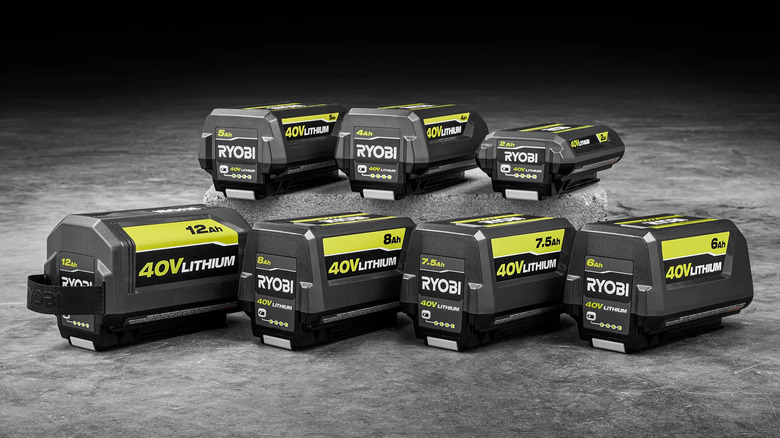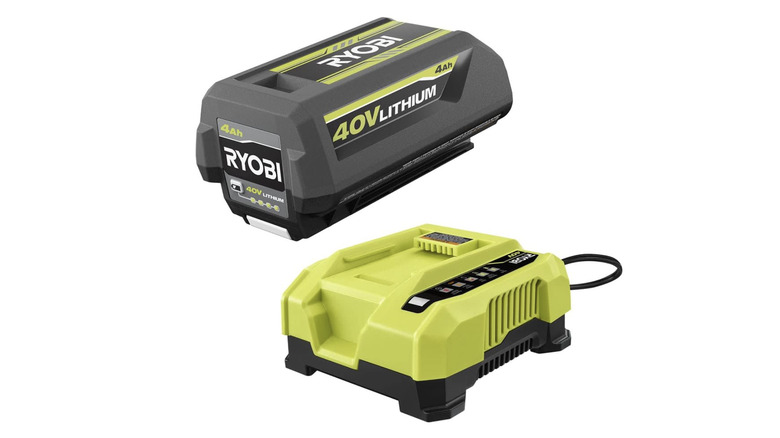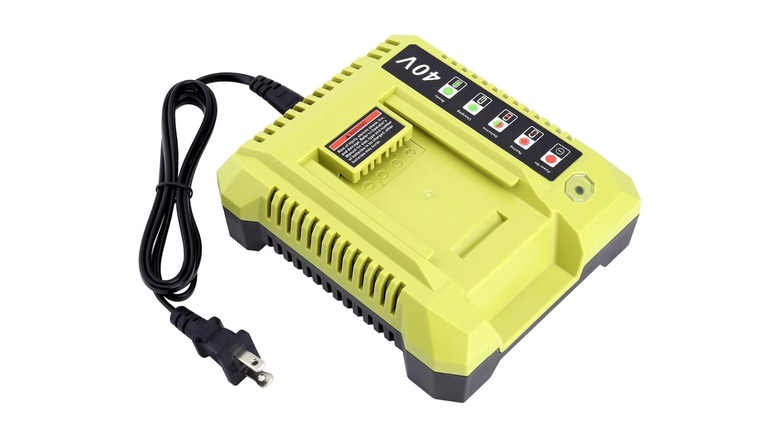Here's Why You Shouldn't Try To Charge A Ryobi 40V Battery Without A Proper Charger
We may receive a commission on purchases made from links.
As with any hardware brand that deals extensively in power tools operating on batteries, Ryobi also maintains multiple systems of battery technology, from its general-use 18V ONE+ tools to its beefier 40V packs. While the 40V packs boast higher voltage for heavier-duty tools, the general concept is the same: Both systems make use of lithium-ion power cells, delivered into a tool via specialized power delivery terminals. A Ryobi 40V pack, in particular, is a little closer to a traditional battery than its 18V sibling, as it uses a flat body with connecting rails rather than the distinctive stalk shape of the ONE+ system.
While the 40V packs bear similarities to battery packages sold by other brands, that doesn't mean you can use any old charger to juice them up. Genuine Ryobi batteries need to be used with their corresponding Ryobi components, including chargers, in order to ensure the battery's continued safety and efficacy. Ryobi chargers are built with the necessary tech and protections to facilitate this, and while it's technically possible to recharge a 40V battery with a third-party charger or extensive modification, doing so is more likely to just break it rather than save you any money or effort. Considering some Ryobi 40V batteries have exploded, it's probably best to make sure you are properly charging it.
Ryobi's lithium chargers are built with special tech and protections
As Ryobi's 40V batteries use lithium-ion power cells to store electricity, any chargers designed to be used with them have a baseline requirement of safety and functionality, both to protect the batteries themselves and anyone using them. After all, while lithium-ion cells are good at storing power, it only takes a bit of mistreatment for them to turn into a full-on fire hazard.
The first and foremost requirements present in Ryobi's 40V chargers are overheating and overcharging protection. When a lithium-ion battery is charged past its maximum capacity, the power cells can become unstable from the electrical influx. If there's too much power in the cells, the battery may experience thermal runaway, generating an uncontrollable level of heat that could eventually lead to a fire or explosion. Ryobi chargers are built to automatically shut off when a connected battery is at full capacity to ensure this doesn't happen.
In a similar vein, Ryobi chargers have built-in overheating protection, both to prevent the aforementioned thermal runaway and to protect the battery in general. The Ryobi 40V Hyper Charger, for instance, has an active cooling feature to help keep the pack within a safe temperature range while it's being charged. Besides these vital safety features, Ryobi chargers are also equipped with monitoring technology that directly communicates with the circuitry and power cells in a battery. This both gives you an accurate readout of the battery's current power percentage and ensures that every cell in the pack is actually receiving energy.
It's technically possible to use a different charger, but it's not advisable
Admittedly, much like Ryobi's 40V batteries themselves, the chargers that go with them can be prohibitively expensive, with pricing ranging from $69 to $349. Given that, you may be tempted to find some cheaper shortcut for keeping your 40V packs charged up. However, you might want to just make the investment on an official, reliable charger, because the alternatives are not as safe.
Since the 40V packs use lithium ion cells, it's theoretically possible to recharge them through direct modification, such as opening up the case and wiring them to a power source. First of all, this would require some extensive knowledge in both mechanics and electrical work. At the same time, it definitely wouldn't charge the battery in an optimal or safe manner. You'd basically have to guess when the battery has enough power, and leaving it too long could lead to severe damage.
A somewhat safer choice would be to use a knock-off charger. You could find a generic 40V charger that fits one of Ryobi's packs on platforms like Amazon. While these unofficial chargers may claim to have the same protective features as Ryobi's chargers, though, you don't really have any way of getting assurance of that. The safety features may be missing or half-baked, and you may not be able to contact these brands for assistance. In contrast, if something goes wrong while using official Ryobi batteries and chargers, there are more protections in place.


